- Author: Kathy Keatley Garvey
It's a sin to kill a mockingbird, wrote Pulitzer Prize-winning author Harper Lee in her classic novel, "To Kill a Mockingbird."
"Mockingbirds don't do one thing except make music for us to enjoy," one of her characters, Miss Maudie, wisely observed. "They don't eat up people's gardens, don't nest in corn cribs, they don't do one thing but sing their hearts out for us. That's why it's a sin to kill a mockingbird."
Harper Lee's work came to mind yesterday when we saw a praying mantis devouring a monarch butterfly on our butterfly bush, located next to several milkweed plants. We watched the clipped monarch wings flutter down and land among the leaves.
It was a female monarch. She may have stopped to sip some nectar during her egg-laying mission. The hungry predator ambushed her.
The shock of seeing a delicate monarch gripped between spiked forelegs stuns you, especially when you've just reared two monarchs and have two more to go.
"Umm, do you mind?" we wanted to ask the mantis. "Please eat the cabbage white butterflies, stink bugs and aphids, not the monarchs."
Praying mantids are considered beneficial insects, but all we've seen them eat are honey bees, sunflower bees, butterflies and an occasional Gulf Fritillary caterpillar. However, they do eat ants, wasps, flies, and moths, as well. The larger praying mantids prey on hummingbirds.
The Xerces Society for Invertebrate Conservation summed up the monarch decline well on its website: "Monarch butterflies (Danaus plexippus) of North America are renowned for their long-distance seasonal migration and spectacular winter gatherings in Mexico and California. The monarch butterfly population has recently declined to dangerously low levels. In the 1990s, estimates of up to one billion monarchs made the epic flight each fall from the northern plains of the U.S. and Canada to sites in the oyamel fir forests north of Mexico City, and more than one million monarchs overwintered in forested groves on the California Coast. Now, researchers and citizen scientists estimate that only about 56.5 million monarchs remain, representing a decline of more than 80% from the 21 year average across North America."
Okay, praying mantis. We know. It was only one. You have to eat, too. You needed the protein to lay your ootheca. But have you ever considered how tasty and prevalent cabbage white butterflies are?
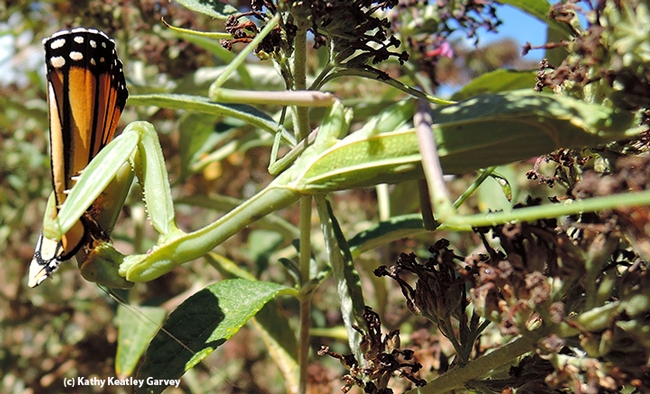
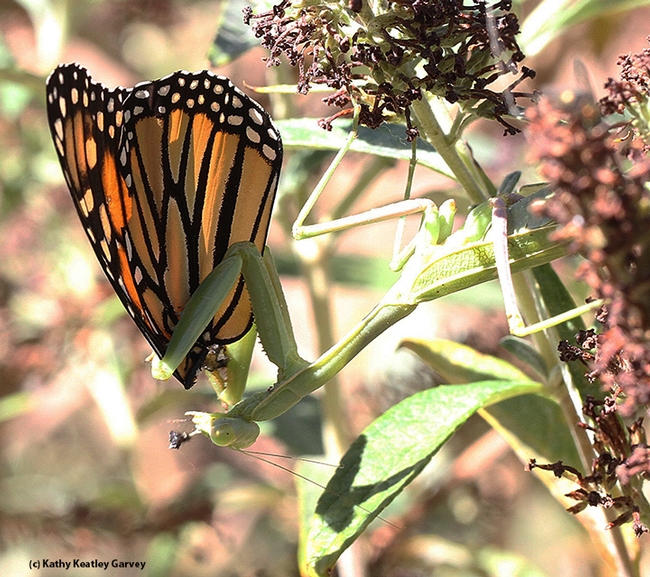
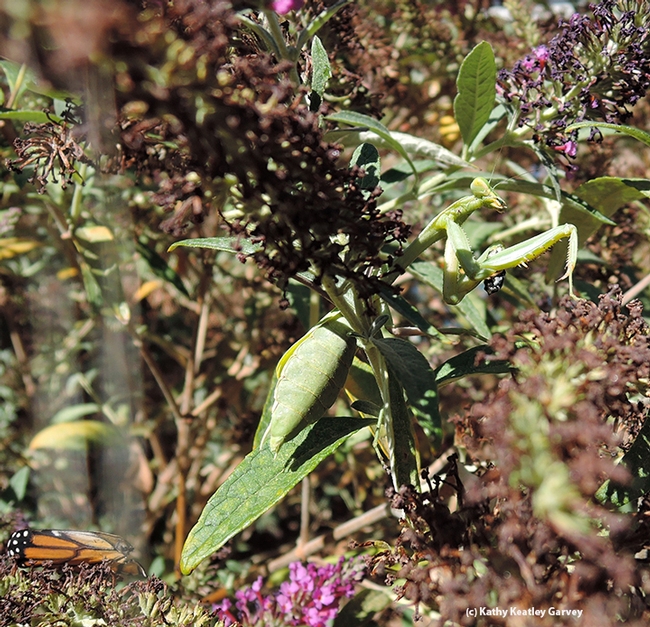
- Author: Kathy Keatley Garvey
Broken Wing belongs here.
And that's a good thing, because he won't live long.
A male monarch that we've nicknamed “Broken Wing” due to a predator mark, hangs out on our milkweed, butterfly bush and Mexican sunflower (Tithonia). He's probably looking for a meal and a mate. Not necessarily in that order.
Scrub jays watch Mr. Danaus plexippus zigzag over the garden and try to nail him. Missed! Hey, didn't you get the message that monarchs don't taste good?
One scub jay, oblivious to the crippled butterfly, perched on our cherry-laurel lined fence today with an acorn in its mouth. Better that than our butterfly.
Praying mantids in our yard would like to make a meal of Broken Wing, too, along with ants, wasps, and dragonflies, not to mention Jeremiah, the American bullfrog that resides in our fish pond.
One thing's for sure: Broken Wing won't be migrating to an overwintering spot in Santa Cruz or Pacific Grove any time soon. He won't be migrating anywhere.
One of the casualties of predator-prey interactions..,
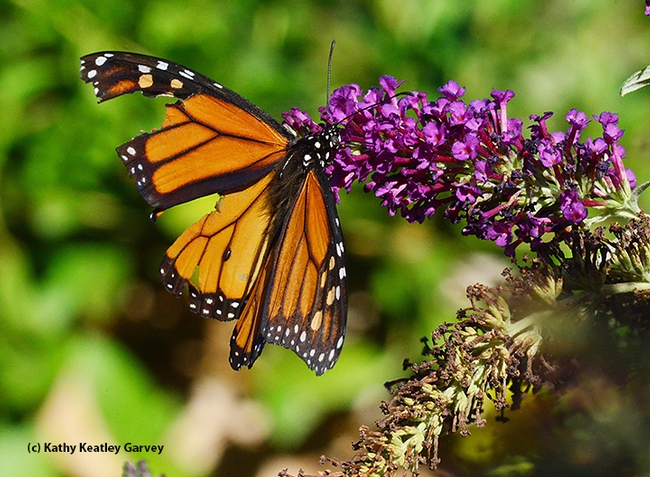
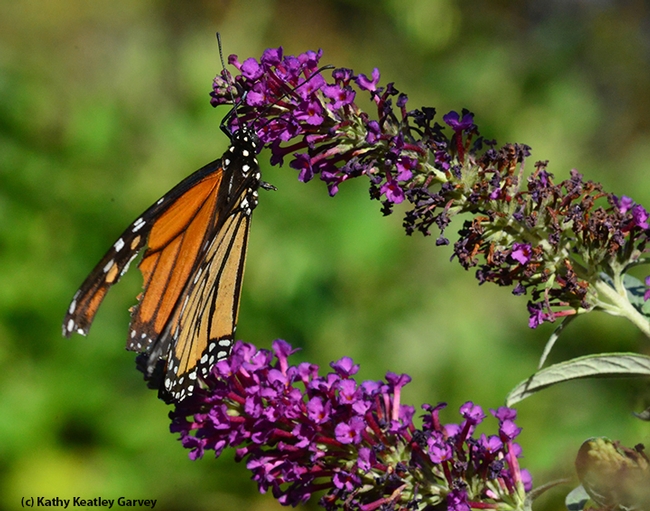
- Author: Kathy Keatley Garvey
Have you ever seen a monarch butterfly (Danaus plexippus) lay an egg on her host plant, the milkweed?
Have you ever seen a close-up of the egg? The larva or caterpillar? The chrysalis? The eclosure (when the adult emerges from the chrysalis)?
It's a fascinating sight.
Not all eggs will make it. Predators, such as lady beetles and their larvae, gobble up monarch eggs along with those tasty aphids. Birds, such as scrub jays, swoop down and make off with an occasional caterpillar. Then when the fifth instar finally starts to form a chrysalis, there's always the question of whether it will do so. Some are deformed and turn out to be half chrysalis and half caterpillar.
But once you've watched a complete metamorphosis, you'll never underappreciate monarchs again. In fact, you'll probably start rearing them every year. We just reared our first two this month.
It's easy to see why teachers and their students get so excited. We remember writing about Sal (Sally) Levinson's newly published book, Butterfly Papercrafts, which contains 21 indoor projects for outdoor learning. Levinson, who studied entomology at the graduate level at UC Riverside and UC Berkeley, wants to inspire youngsters to learn about our amazing world of butterflies through art and a little science.
It's intended for youngsters ages 5-12, but really, it's also a beginner's book for all ages and a teacher's treasure. And it's priced right--under $10 ($9.99). Readers can learn about the life cycle, from egg to caterpillar to chrysalis to adult; and craft a butterfly paper airplane, a caterpillar flip book, and a monarch finger puppet.
Meanwhile, North America's monarchs are heading for their overwintering sites in two main areas: the mountains of central Mexico, and choice spots along the California coast, including Pacific Grove and Santa Cruz.
"The annual migration of North America's monarch butterfly is a unique and amazing phenomenon," according to the U.S. Department of Agriculture's Forest Service website. "The monarch is the only butterfly known to make a two-way migration as birds do. Unlike other butterflies that can overwinter as larvae, pupae, or even as adults in some species, monarchs cannot survive the cold winters of northern climates. Using environmental cues, the monarchs know when it is time to travel south for the winter. Monarchs use a combination of air currents and thermals to travel long distances. Some fly as far as 3,000 miles to reach their winter home."
You'll see a migration map on the Forest Service website. You can check out the monarch sightings on this map and report the ones you see.
Go, monarchs!

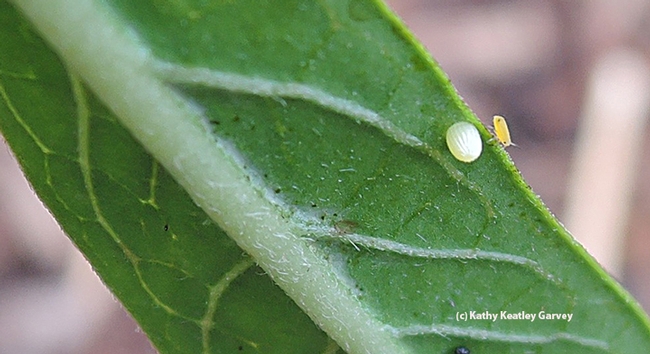


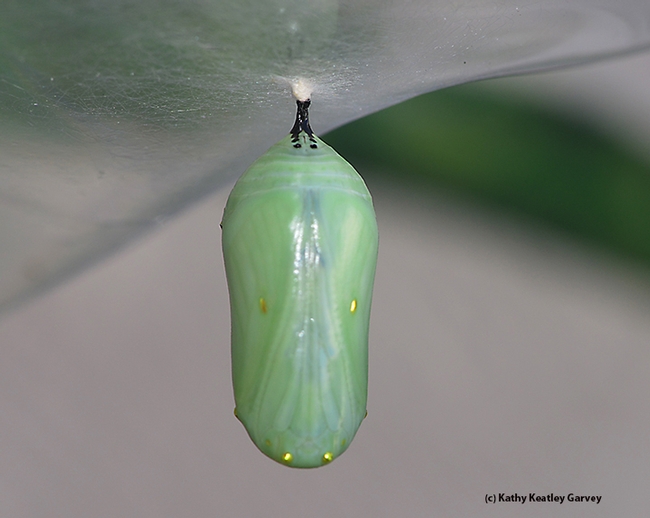
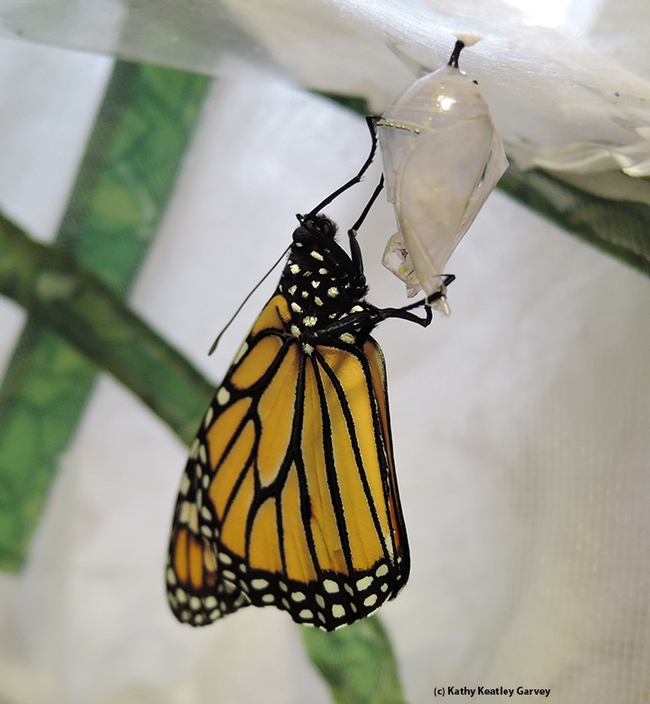

- Author: Kathy Keatley Garvey
Westward, ho!
The western migration of the Monarch butterflies (Danaus plexippus) to their overwintering sites along the California coast is underway.
Butterfly expert Art Shapiro, distinguished professor of evolution and ecology at the University of California, Davis, recorded four Monarchs at his Suisun monitoring site yesterday. He's been monitoring butterflies in Central California for some four decades.
This morning, a male Monarch fluttered into our yard to sip some nectar from a Mexican sunflower (Tithonia). (A distinguishing feature of the male Monarch: a small black spot on each of its two hindwings. See photo below.)
Monarchs head for sites along the coast, including Santa Cruz, Monterey, Natural Bridges and Pacific Grove, to overwinter, Shapiro noted.
"There used to be a small site in Fairfield, near the old Juvenile Hall on West Texas Street, in a row of Eucalyptus. It's been gone for decades. Some years they try to overwinter in Marin and Sonoma counties, but usually give up and shift south in December. In the past few years there has been a little winter breeding on the south coast. This was never recorded before."
The migration of the Monarchs to overwintering sites in central Mexico is well-publicized, but some monarchs head for the California coast. According to the monarchwatch.org website, monarchs east of the continental divide generally migrate to central Mexico from as far away as Ontario, Canada. "Monarchs west of the divide fly to the coast of California to spend the winter. They cluster together on tree limbs during the winter months in California by the thousands, and in central Mexico by the millions." (Download the PDF on the monarchwatch.org site.)
We're glad to see the huge national campaign to plant milkweed, the host plant of the Monarchs. The Xerces Society for Invertebrate Conservation has posted a wealth of information on its website for us to take action. The Monarch population has declined by more than 90 percent in under 20 years.
“Monarch butterflies are declining due to loss of habitat,” said Monarch Watch director Chip Taylor. “To assure a future for monarchs, conservation and restoration of milkweeds needs to become a national priority.”
It also helps to provide nectar resources for the Monarchs to help them along in their migration. In our yard, they like the Mexican sunflower (Tithonia), the butterfly bush (Buddleia davidii), and blue beard (Caryopteris × clandonensis). See list of Monarchs' favorite plants on the monarchwatch.org site.
Meanwhile, an occasional Monarch flutters into our family bee/butterfly garden to sip some nectar. Sometimes territorial native bees chase them away but the Monarchs return, determined to grab some flight fuel.
Westward, ho!
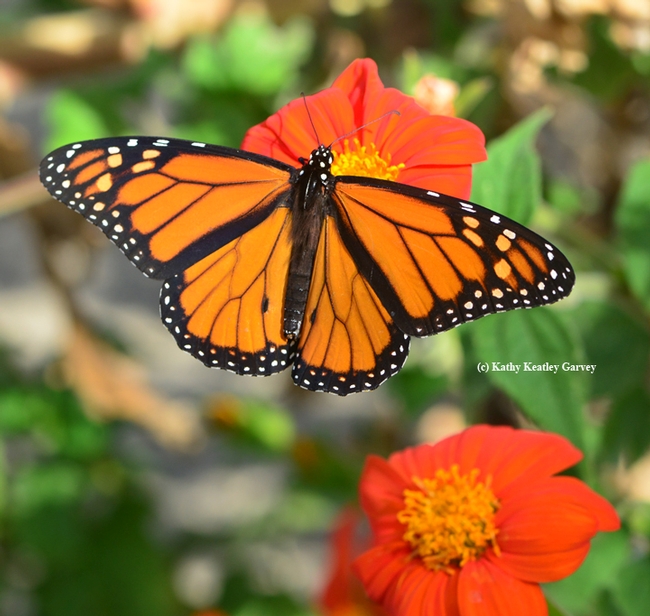


- Author: Kathy Keatley Garvey
When a monarch butterfly comes fluttering through your yard, grab your camera. Marvel at it beauty, celebrate its presence, and keep it in your memory. It may be become an endangered species the way things are going.
The Xerces Society for Invertebrate Conservation recently reported that the monarch population has declined by more than 90 percent in under 20 years. And, “during the same period it is estimated that these once-common iconic orange and black butterflies may have lost more than 165 million acres of habitat — an area about the size of Texas — including nearly a third of their summer breeding grounds.”
So a trio—Center for Biological Diversity, Center for Food Safety, and the Xerces Society—filed a legal petition asking the U.S. Fish and Wildlife Service for Endangered Species status to protect the monarch (Danaus plexippus).
The widespread loss of milkweed, the butterfly's host plant, especially throughout the Midwest, is troubling.
Butterfly expert Art Shapiro, distinguished professor of evolution and ecology at the University of California, Davis, says there's plenty of milkweek in Northern California. “The problem is that nobody's there to breed on it.” For example, he sees large spreads of milkweed (Asclepias speciosa) around his many monitoring sites, including one by the Vacaville (Calif.) Transit Center. “Probably 75 stems, but I have never ever seen a monarch there, let alone any evidence of breeding." (See his entry on monarchs on his website.)
So, a monarch's solo visit to our little bee garden seems like a major event. When we see one, as we did Sept. 17, it heads straight for the Mexican sunflower (Tithonia).
Backlit, the monarch resembles a stained glass window. What a gorgeous butterfly, worthy of the royal name, “monarch!”
The only question is: will we consider it worthy enough to save it?
- Plant milkweed, its host plant.
- Avoid insecticides or herbicides.
- Become a citizen scientist and help record sightings.
- Support conservation efforts.
- Promote public awareness.
The Xerces Society's information on its website on the mighty monarch should be required reading, as should be this website: Monarch Watch.





